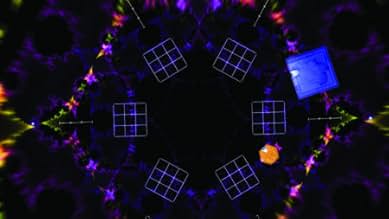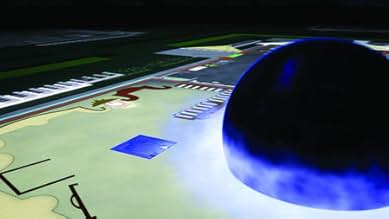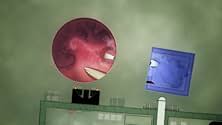अपनी भाषा में प्लॉट जोड़ेंBased on Edwin Abott's book "Flatland", this is an animated film about geometric characters living in a two-dimensional world. When a young girl named "Hex" decides to "think outside the box... सभी पढ़ेंBased on Edwin Abott's book "Flatland", this is an animated film about geometric characters living in a two-dimensional world. When a young girl named "Hex" decides to "think outside the box" (in a world where such thought is forbidden), her life becomes in danger and it is up to... सभी पढ़ेंBased on Edwin Abott's book "Flatland", this is an animated film about geometric characters living in a two-dimensional world. When a young girl named "Hex" decides to "think outside the box" (in a world where such thought is forbidden), her life becomes in danger and it is up to her grandfather to save her life.
- Hex
- (वॉइस)
- Spherius
- (वॉइस)
- Abbott Square
- (वॉइस)
- Arlene Square
- (वॉइस)
- Pantocyclus
- (वॉइस)
फ़ीचर्ड समीक्षाएं
The source material for both is the 1884 novella by Edwin A. Abbott, but the approaches of the two films differ radically. The book is a staple of science fiction, and one of the few to address mathematical issues at its core. Being a product of its time, the book is technically naive, and politically incorrect based on current sensibilities.
The Travis film is visually slicker, but significantly shorter, and tackles philosophical issues relative to the passage of time from initial publication. As such, it tampers with the plot to mixed effect. Unlike some others, I have no problem with some of the revisions to the underlying plot since they do help bring some of the book's major issues into somewhat sharper focus. On the other hand, they also add a "feel good" and politically correct sensibility that seems out of place.
The Ehlinger film is much truer to its source material, which is both a strength and a weakness. Given a current perspective, its 19th century depiction of the political and social subjugation of women is a distraction that the Travis film avoids. It's also a longer film and could have been more effective with some of the same plot and editing license employed in the Travis film. Where it does tamper with the plot, some of the decisions are questionable as other reviewers have pointed out.
So which is better? In my opinion, the short answer is the Ehlinger film. Despite its length, political incorrectness, and technical inferiority (the animation of the Travis film is much more sophisticated), it resonates at a technical level to a degree that the Travis film can't match. As a scientist, this means a lot to me. On the other hand, the Travis film resonates on an emotional level that the Ehlinger film can't match. So the answer may be whether you're looking for technical insight or emotional satisfaction.
Most jarring in the Travis film is that, unlike the Ehlinger film, the animators never quite caught on to the implications of a two-dimensional universe. It is filled with objects which are instantly recognizable to us, yet would be clearly impossible or meaningless in the film's reality (e.g. the protagonist's daughter has toys which only make sense to someone with a 3-D perspective, and how does he open his briefcase?). The cover art is an obvious first impression example. The Travis film's characters look more human, but ask yourself how their eyes work. One detail of the book is that looking at a Flatlander from above, all of his internal organs are clearly visible, as they should be. Travis' animators hint at this, but don't meet it head-on. The Ehlinger film's animators may not have had the resources to make as slick a film as Travis', but they obviously gave a great deal of thought to what they were doing (or maybe not, since the necessary designs were all in the book). In short, Travis had the budget, but Ehlinger had the passion for the project - albeit perhaps a bit too much respect for the source to create a truly superior adaptation.
The differences reflect different target audiences, though. The Travis film is an educational short film which was obviously meant to be viewed by classrooms of middle school and high school students. As such, it had to be socially inoffensive while conveying concepts of geometry that would never occur to non-mathematicians. That it includes recognizable names voicing the characters will help it grab a bit more attention - an educational short film for the "X-Files" generation. The Ehlinger film would mostly appeal to people with a college level interest in mathematics, or others who are already familiar with the book.
Neither film is perfect, but I'm giving the Ehlinger film a rating of 8 and the Travis film a rating of 6. Depending on your sensibilities, your conclusion may be exactly opposite of mine, so I hope this review includes enough information to guide you to an informed selection.
Or, like me, you could simply buy both... ;-)
The novel was deep and meaningful and this film is light and useless. I was hoping for something close to the original with some helpful graphics. There was some value graphically speaking as far as illustrating the dimensions and this would have been very challenging no doubt. But to completely change the story line and turn it into some kind of mediocre fairy tale was a huge mistake in my opinion.
If you are a fan of the novel and are looking here to see if watching this film is worth it, it's not. Don't do it to yourself. You have been warned.
Annoying things about the film: the plot is stupid and so slow, the voices and dialogs intolerable, the characters I would not even be able to call flat... There are 'signs' at the beginning which are supposed to be funny, but simply come off as insults, treating the viewer as an imbecile who cannot tell what to pay attention to. So bad. Let's turn to 'math,' then.
It's impossible for a 2D organism with a 1D retina to suddenly 'see' in 3D. He would continue to see the perspective through a plane (e.g. slices of his conspecifics, seen from above in a single plane crossing the flatland, NOT a bird eye's view. On the other hand, it is false for a 2D object NOT to have an idea of what perspective is (it is still the case that an object will appear bigger when closer in 2D).
Too bad to continue. Better check out the book in the Guttenberg project.
I attended a talk at the 2012 Wisconsin Science Festival called "Science and Storytelling" and the presenter showed us a 30-minute film that was just like any other PBS documentary about a scientific concept. Sure, it had a loose narrative on how this discovery led to that breakthrough which led to this experiment, but that's not a STORY.
A story is what Dano Johnson has created with the FLATLAND films. A story has great characters, something at stake, and reversals of expectation.
The world of science doesn't have enough myths to its name -- but FLATLAND and FLATLAND 2: SPHERELAND are perfect contributions to that endeavor. As a storyteller/filmmaker myself, I found the FLATLAND films to be incredibly inspiring.
In my experience watching this, everyone in my class loved it and almost busted.... out laughing! Spherius made me learn that there is more dimensions than the amount we live in. It made me and my fellow students question the dimensions and ponder about more dimensions than the 3 we mainly know about. The character development of Arthur Square is amazing from not even thinking about the third dimension to being imprisoned by the circles because he tried to say the truth about the third dimension.
In conclusion Flatland is one of the best educational movies out there!
क्या आपको पता है
- ट्रिवियाThe forbidden area in Flatland is named "Area 33H". "33" in hexadecimal ("H") is "51" in the decimal system, making this a sly reference to Area 51.
- गूफ़The spinning cube at the center of Area 33H shows up as a changing hexagon within Flatland. By analogy, the spinning hypercube at the end of the movie should appear as a changing polyhedral solid, but instead it appears as the full convex-hull three-dimensional projection.
- भाव
Female Boss Circle: [to A Square, who is late arriving at the office] Get to your Square-icle! NOW!
- क्रेज़ी क्रेडिटThe film opens with the following message: 'This movie has been modified from its original version. It has been formatted to fit your Spaceland screen. Certain elements from Flatland have been altered to be recognizable by three-dimensional beings. Any similarity to people, places or objects in our world is purely coincidental.'
- कनेक्शनReferenced in Dragon Day (2013)
टॉप पसंद
विवरण
- कंट्री ऑफ़ ओरिजिन
- आधिकारिक साइट
- भाषा
- इस रूप में भी जाना जाता है
- Flatland
- फ़िल्माने की जगहें
- उत्पादन कंपनी
- IMDbPro पर और कंपनी क्रेडिट देखें
- चलने की अवधि34 मिनट
- रंग
इस पेज में योगदान दें



























